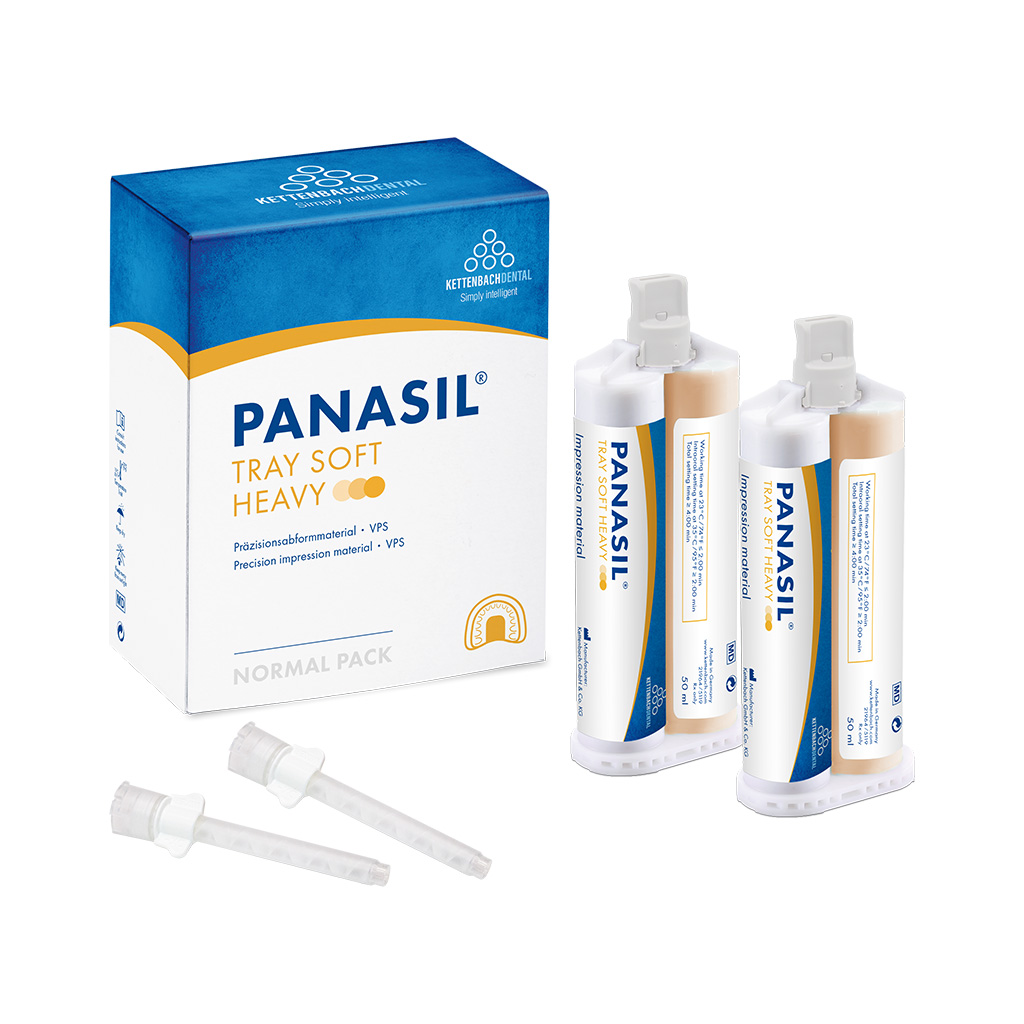Panasil Family Evaluation
The Panasil family of impression materials offers high tear strength, hydrophilic and elastic properties, and strong resistance to deformation—resulting in consistently accurate final impressions
Final impression-taking can be challenging, especially when working with patients who have deep margins or gingival bleeding, or during mixed implant and crown-and-bridge cases. Since dental impressions are the launching pad for all laboratory procedures, it’s important to achieve accuracy in every patient scenario.
 Dr. Edward Lew was hoping for just that: An impression material that would work in all fields and produce clear margins. He recently needed to take an impression on a patient’s tooth No. 18, which was a challenge due to cord packing, bleeding, and heavy saliva flow. He was hesitant to take the impression, fearing a poor result, but the patient needed a final restoration right away. After using Kettenbach’s Panasil impression materials, he shared, “The impression came out to be good even in a wet field and gave me the confidence to use the product in more nonideal situations.”
Dr. Edward Lew was hoping for just that: An impression material that would work in all fields and produce clear margins. He recently needed to take an impression on a patient’s tooth No. 18, which was a challenge due to cord packing, bleeding, and heavy saliva flow. He was hesitant to take the impression, fearing a poor result, but the patient needed a final restoration right away. After using Kettenbach’s Panasil impression materials, he shared, “The impression came out to be good even in a wet field and gave me the confidence to use the product in more nonideal situations.”
Panasil’s robust line of products are A-silicone-based precision impression materials with elastic and hydrophilic properties, high tear strength, dimensional accuracy, and a strong resistance to permanent deformation.
Here’s a roundup of what Dr. Lew and 13 other evaluators thought after trying this silicone impression material in their offices.
Viscosities
The trio of wash materials in the Panasil family — which come in low, extra low, and medium viscosities — are expertly coordinated with Panasil tray materials to offer precise results. Dr. Jacob Scheiner, whose favorite feature of Panasil was its flow and lack of bubbles, noted, “The 2 consistencies mixed very well as one without any demarcations.” Dr. R.J. Sondkar added that the viscosity and flow characteristics of the silicone impression material worked very well in reducing voids. “Viscosity is just perfect with both the wash and the heavy body that complement each other well,” he added.
Panasil impression materials have very high initial hydrophilicity that lasts throughout working time. Because of this, Dr. Russell Duke observed that the material “flowed better and was not deterred by moisture,” which yielded more accurate margins. Also lauding Panasil’s consistency was Dr. Troy Schmedding, who said the material offered “great viscosity,” and Dr. Ken Hsu, who appreciated its flowability.
Describing an implant post impression on a patient who had long teeth and bridges, Dr. William Davidson shared, “I needed a material to be strong and rigid enough for accurate capture of the impression post, yet flexible and tear resistant enough to capture the bridge without locking on.” He concluded that “[Panasil] worked beautifully.”
|
"Panasil worked |
"Best all-around |
"Panasil made
|
| William Davidson, DMD Northfield, OH |
Jason Wetmore, DMD Rockledge, FL |
Russell Duke, DMD Rio Rico, AZ |
Working and Setting Time
Panasil impression materials boast short intraoral setting times of 2 to 3 minutes, with adequate working times. Dr. Pierre Obeid noted that Panasil had “good working and setting times,” which was also his favorite feature of the material, and Dr. Duke agreed, sharing, “Set times are great, as well as handling properties.”
Dr. Jason Wetmore’s patients commented that the material had a good taste and that they appreciated the quick, 2-minute setting time, while Dr. Jeffrey Krantz felt that the “setting time is a little quick for my tastes.” An upgrade from his current impression-taking process, Panasil provided Dr. Davidson with “quick, easy impressions without the bulky mechanical mixer I currently use.”
Accuracy at the Margin
Tray materials in the Panasil family offer optimal pressure buildup and ahigh tensile strength to ensure precise impressions. Dr. Wetmore, who used the material in full arch prosthetic, mixed implant, and crown-and-bridge cases, said he avoided retakes, which resulted in “great partial and denture impressions” with clear margins and limited pulls. For Dr. Sondkar, who was hoping the material would eliminate distortions and accurately register prep, Panasil offered “clear, well-defined margins,” and a “good quality impression that met the criteria to send to the lab.”
Before trying Panasil in his office, Dr. Obeid was searching for consistency and accuracy in his impression-taking. He shared that Panasil materials were “very accurate and easy to handle,” and Dr. Hsu agreed, noting that there were no bubbles in his crown-and-bridge impressions and no need for retakes. Speed and accuracy were Dr. Davidson’s favorite features of Panasil, and Dr. Eric Leibowitz said it offered a better impression because he did not need to reline.

"Panasil worked in fields that may have not been ideal, such as some bleeding of the gingiva."
-Edward Lew, DMD
Los Angeles, CA
Overall Satisfaction
Sharing that Panasil impression material was a great product that he enjoyed using, Dr. Duke concluded, “It made me more confident in my impression-taking technique.” Dr. Krantz praised its neutral taste that resulted in higher patient acceptance. “This is an excellent system of products,” he said, adding, “The resulting impressions produced models that yielded an excellent clinical outcome.” And lauding its consistent results, Dr. Lew summed up his experience by saying, “With so many impression materials on the market, [Panasil] definitely deserves your attention and is worth a try.”
Takeaways
•A-silicone-based impression materials with hydrophilic and elastic properties
•High tensile strength ensures precise impressions
•Short intraoral setting time of 2-3 minutes
•Available in a range of viscosities to accommodate all impression types









